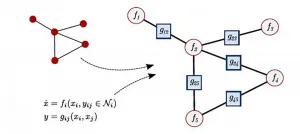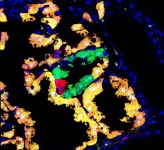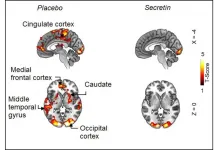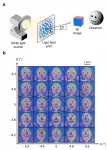First wave COVID-19 data underestimated pandemic infections
Advanced uncertainty quantification model based on fluid dynamic simulations of weather effects corrects COVID-19 pandemic's first wave data inaccuracies
2021-06-22
(Press-News.org) WASHINGTON, June 22, 2021 -- Two COVID-19 pandemic curves emerged within many cities during the one-year period from March 2020 to March 2021.
Oddly, the number of total daily infections reported during the first wave is much lower than that of the second, but the total number of daily deaths reported during the first wave is much higher than the second wave.
This contradiction inspired researchers from the University of Nicosia in Cyprus to explore the uncertainty in the daily number of infections reported during the first wave, caused by insufficient contact tracing between March and April 2020.
In Physics of Fluids, from AIP Publishing, Talib Dbouk and Dimitris Drikakis report using environmental fluid dynamics -- advanced computational multiscale multiphysics modeling and simulations -- to develop a constitutive relationship between weather seasonality conditions, such as temperature, relative humidity, and wind speed, and having two pandemic curves per year.
"We integrated a new physics-based relationship into a pandemic forecast model that accurately predicted, as it was later observed, a second COVID-19 pandemic wave within many cities around the world, including New York," said Drikakis.
Most, if not all, of the data for the daily number of total new infections reported during the first wave of the pandemic were underestimated and used incorrectly.
"Within the city of New York, our work shows that the daily number of new infections reported during the first wave was underestimated by a factor of four," Dbouk said. "So, the uncertainty of first-wave data mixed with second-wave data means the general conclusions drawn can be misleading, and everyone should be aware of this."
The researchers' work is the first known case of deriving an advanced uncertainty quantification model for the infected cases of the pandemic's first wave based on fluid dynamic simulations of weather effects.
"Our model is physics-based and can rectify first-wave data inadequacies by using second-wave data adequacy within a pandemic curve," said Drikakis. "Our proposed approach combines an environmental weather seasonality-driven virus transmission rate with pandemic multiwave phenomena to improve the data accuracy of statistical predictions."
In the future, the researchers' proposed uncertainty quantification model may help correct the worldwide total number of daily coronavirus infections reported by many cities during the first wave of a pandemic.
INFORMATION:
The article, "Correcting pandemic data analysis through environmental fluid dynamics," is authored by Talib Dbouk and Dimitris Drikakis. It will appear in Physics of Fluids on June 22, 2021 (DOI: 10.1063/5.0055299). After that date, it can be accessed at: https://aip.scitation.org/doi/10.1063/5.0055299.
ABOUT THE JOURNAL
Physics of Fluids is devoted to the publication of original theoretical, computational, and experimental contributions to the dynamics of gases, liquids, and complex fluids. See https://aip.scitation.org/journal/phf.
[Attachments] See images for this press release:
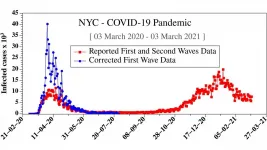
ELSE PRESS RELEASES FROM THIS DATE:
2021-06-22
WASHINGTON, June 22, 2021 -- Emerging open-source programming language Julia is designed to be fast and easy to use.
Since it is particularly suited for numerical applications, such as differential equations, scientists in Germany are using it to explore the challenges involved in transitioning to all-renewable power generation.
Decarbonization implies a radical restructuring of power grids, which are huge complex systems with a wide variety of constraints, uncertainties, and heterogeneities. Power grids will become even more complex in the future, so new computational tools are needed.
In Chaos, from AIP Publishing, Potsdam Institute for Climate Impact Research (PIK) scientists describe a software package they built to enable the simulation of general dynamical ...
2021-06-22
WASHINGTON, June 22, 2020 -- Most models explaining how viruses are transmitted focus on viral particles escaping one person to infect a nearby person. A study on the role of microscopic particles in how viruses are transmitted suggests pollen is nothing to sneeze at.
In Physics of Fluids, by AIP Publishing, Talib Dbouk and Dimitris Drikakis investigate how pollen facilitates the spread of an RNA virus like the COVID-19 virus. The study draws on cutting-edge computational approaches for analyzing fluid dynamics to mimic the pollen movement from a willow ...
2021-06-22
Genetic mosaic individuals, which contain cells of different genotypes, arise naturally in multicellular organisms. In humans, the development of cancer - where one cell acquires a mutation that allows it to proliferate, while other cells don't - is a prime example of genetic mosaicism. But inversely, genetic mosaicism can be used to study and understand the development of disease.
A common quirk of nature used to understand genes
One experimental genetic mosaic approach is called Mosaic Analysis with Double Markers (MADM), in which genes are mutated in individual cells while, at the same time, the mutated cells are labelled in fluorescent colors. ...
2021-06-22
Scientists at Nagoya University, with colleagues at Kyoto University in Japan, have uncovered a mechanism that allows a protein complex to bind to DNA without impeding some of the important processes of cell division. Their findings, published in the journal Cell Reports, could further understandings of developmental disorders arising from mutations in the gene that codes for the complex.
DNA condenses during cell division to form structures called chromosomes that are formed of two identical copies, called sister chromatids. These sister chromatids are bound together by proteins called cohesins, until it is time for them to be pulled apart and directed into the newly formed cells. Scientists know quite a bit about the ...
2021-06-22
The venom of a caterpillar, native to South East Queensland, shows promise for use in medicines and pest control, Institute for Molecular Bioscience researchers say.
The Doratifera vulnerans is common to large parts of Queensland's south-east and is routinely found in Toohey Forest Park on Brisbane's southside.
Dr Andrew Walker has been researching the striking looking caterpillar since 2017.
"We found one while collecting assassin bugs near Toowoomba and its strange biology and pain-causing venom fascinated me," Dr Walker said.
Unlike The Very Hungry Caterpillar that charmed generations of children around ...
2021-06-22
"Detecting primordial black holes opens up new perspectives to understand the origin of the Universe, because these still hypothetical black holes are supposed to have formed just a few tiny fractions of a second after the Big Bang. Their study is of great interest for research in theoretical physics and cosmology, because they could notably explain the origin of dark matter in the Universe". You can see stars in the eyes of the members of the team led by Professor Fuzfa, astrophysicist at UNamur, when talking about the perspectives of their research. This project is the result of an unprecedented collaboration between the UNamur ...
2021-06-22
Researchers from the Turku PET Centre and Technical University of Munich have discovered a new mechanism controlling satiation. According to the recently published study, the hormone secretin induces satiation by activating brown adipose tissue.
Brown adipose tissue is known for its ability to generate heat in response to cold exposure. Its activity has been proven to be connected to normal weight and glucose metabolism as well as lesser risks of cardiovascular diseases. Meals have also been shown to increase the thermogenesis in brown fat, but the significance of this phenomenon has been unclear. ...
2021-06-22
Teacher training students who practised teaching virtual pupils developed greater confidence in their teaching ability, according to a study from Linköping University. In the long term, simulation can make the students better prepared for their workforce debut.
Teacher training programmes often have difficulty offering their students sufficient teaching practice for their future profession. Many teaching graduates feel unprepared when they start working, and some decide to change career path, despite good employment prospects caused by a teacher shortage.
A group of researchers at Linköping University investigated whether teaching virtual pupils could make teacher training students better prepared for teaching in a real classroom.
"By ...
2021-06-22
Wouldn't it be amazing if printed images can look three-dimensional (3D)? Unfortunately, conventional prints like photographs display two-dimensional (2D) images with a fixed appearance as they contain only intensity and colour information. These prints are unable to display a 3D image because they lack directional control of light rays, hence resulting in the loss of depth information.
To address this problem, a team of researchers from the Singapore University of Technology and Design (SUTD) used a nanoscale 3D printing technique to create high-resolution light field prints ...
2021-06-22
A research team led by Professor Jang-Sik Lee of Pohang University of Science and Technology (POSTECH) has successfully developed the halide perovskite-based memory with ultra-fast switching speed. The findings from this study were published in Nature Communications on June 10, 2021.
Resistive switching memory is a promising contender for next-generation memory device due to its advantages of simple structure and low power consumption. Various materials have been previously studied for resistive switching memory. Among them, halide perovskites are receiving much attention for use in the memory because of low operation voltage and high on/off ratio. However, halide perovskite-based ...
LAST 30 PRESS RELEASES:
[Press-News.org] First wave COVID-19 data underestimated pandemic infections
Advanced uncertainty quantification model based on fluid dynamic simulations of weather effects corrects COVID-19 pandemic's first wave data inaccuracies

